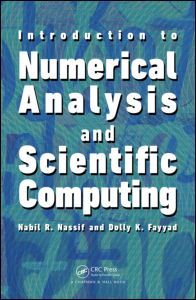Introduction to Numerical Analysis and Scientific Computing
Auteurs : Nassif Nabil, Fayyad Dolly Khuwayri

Designed for a one-semester course, Introduction to Numerical Analysis and Scientific Computing presents fundamental concepts of numerical mathematics and explains how to implement and program numerical methods. The classroom-tested text helps students understand floating point number representations, particularly those pertaining to IEEE simple and double-precision standards as used in scientific computer environments such as MATLAB® version 7.
Drawing on their years of teaching students in mathematics, engineering, and the sciences, the authors discuss computer arithmetic as a source for generating round-off errors and how to avoid the use of algebraic expression that may lead to loss of significant figures. They cover nonlinear equations, linear algebra concepts, the Lagrange interpolation theorem, numerical differentiation and integration, and ODEs. They also focus on the implementation of the algorithms using MATLAB®.
Each chapter ends with a large number of exercises, with answers to odd-numbered exercises provided at the end of the book. Throughout the seven chapters, several computer projects are proposed. These test the students' understanding of both the mathematics of numerical methods and the art of computer programming.
Computer Number Systems and Floating Point Arithmetic. Finding Roots of Real Single-Valued Functions. Solving Systems of Linear Equations by Gaussian Elimination. Polynomial Interpolation and Splines Fitting. Numerical Differentiation and Integration. Advanced Numerical Integration. Numerical Solutions of Ordinary Differential Equations (ODEs). Bibliography. Index.
Date de parution : 09-2013
15.6x23.4 cm
Thèmes d’Introduction to Numerical Analysis and Scientific Computing :
Mots-clés :
Bisection Method; Quadratic Spline Function; Floating Point Number Representations; Back Substitution; Scientific Computer Environments; IEEE Single Precision; Numerical Mathematics; Quadratic Spline; Advanced Numerical Integration; Adaptive Numerical Integration; Program Numerical Methods; IEEE Double Precision; computer arithmetic; Unit Lower Triangular Matrix; floating-point number representations; LU Decomposition; Pivot Equation; numerical linear algebra; Divided Difference Table; nonlinear equations; Natural Cubic Spline; Floating Point System; Cubic Spline; Convex Polygonal Domains; Newton’s Method; Interpolating Polynomial; Floating Point; Composite Simpson’s Rule; Spline Interpolant; Gauss Reduction; Polygonal Domain; Linear Spline; Denormalized Numbers; Index Vector



